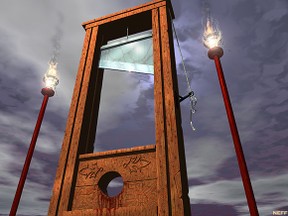 In Saudi Arabia, the victim usually does not know that they are about to be executed until immediately before it occurs. Often, they may not even realize that they have been sentenced to death.
In Saudi Arabia, the victim usually does not know that they are about to be executed until immediately before it occurs. Often, they may not even realize that they have been sentenced to death.
In March 2004, Victor Corea, Ranjith de Silva, Sanath Pushpakumara and Sangeeth Kumara were arrested for armed robbery. The four Sri Lankan nationals were found guilty in October of the same year.
The men believed that they had been given a prison sentence; and the Sri Lankan embassy was given no reason to assume otherwise. Saudi Arabia does not publicize such information, even in diplomatic circles, to thwart international backlash from the like of Amnesty International.
On February 12th 2007, Human Rights Watch spoke with Ranjith de Silva. He appeared confident that the Saudi government were about to apply clemency and pardon the four men. It was reported that they each believed they would be out of prison imminently.
The interest of the activist group was in the fact that the men had been badly beaten while awaiting trial; and they had not been given access to lawyers. They didn't have the chance to pursue the case.
Seven days later, the four Sri Lankan men were given tranquilizers. This, and what followed, is what occurs in all decapitations in Saudi Arabia.
They were taken from their prison cells and driven to a car-park, adjacent to a busy market square. In their case it was in the capital city of Riyadh, but people are executed in similar locations all over the country.
These are always public spectacles and always take place immediately after noon prayers.
A broad plastic covering is placed on the ground and the condemned person is forced to kneel upon it. Their hands and feet are tied behind their backs. They will always have been blind-folded and often are dressed in a white robe. Sometimes a concession is given in allowing the victim to wear his or her own clothes. They will always be bare-foot.
Prayers continue through loudspeakers, as the crowds gather to watch. The victim kneels facing Mecca.
After a few minutes have passed, an Interior Ministry officer steps onto a small platform and reads out the charges.
Meanwhile, a police officer will hand a scimitar to the executioner. It is 3.6ft - 3.7ft (1100mm - 1200mm) long and kept solely for this purpose. The headsman has a few practice swipes in the air to gauge the weight (and to warm up his arm muscles), then touches the tip of the blade against the victim's back.
This is their cue to sit up straight. Within the next instant, the scimitar sweeps down and, if done correctly, beheads the victim in one go.



 Beheading has a long history. It was a mode of execution favored by both the ancient Romans and Greeks for their own citizens. This was carried with the former in particular into all of their conquered nations.
Beheading has a long history. It was a mode of execution favored by both the ancient Romans and Greeks for their own citizens. This was carried with the former in particular into all of their conquered nations.


 Any chicken farmer will tell you that, on slaughter day, the birds flap for a while without their heads. 'Running around like a headless chicken' comes from that very phenomenon.
Any chicken farmer will tell you that, on slaughter day, the birds flap for a while without their heads. 'Running around like a headless chicken' comes from that very phenomenon.


 On June 28th 1905, the murderer Henri Languille was decapitated in Place Bel Air, Orléans, France. As with all victims of capital punishment in that country, at that time, the guillotine was used to sever his head from his body.
On June 28th 1905, the murderer Henri Languille was decapitated in Place Bel Air, Orléans, France. As with all victims of capital punishment in that country, at that time, the guillotine was used to sever his head from his body. Guest
on 07/05/2012
Guest
on 07/05/2012

 In Saudi Arabia, the victim usually does not know that they are about to be executed until immediately before it occurs. Often, they may not even realize that they have been sentenced to death.
In Saudi Arabia, the victim usually does not know that they are about to be executed until immediately before it occurs. Often, they may not even realize that they have been sentenced to death.








 St Tydecho's Churches in West Waleson 09/03/2014
St Tydecho's Churches in West Waleson 09/03/2014
 Goodies for an Outlander Premiere Partyon 03/06/2015
Goodies for an Outlander Premiere Partyon 03/06/2015
 Holocaust Memorial Day Interview with Rainer Höss, Grandson of Rudolf Architect of Auschwitzon 01/24/2015
Holocaust Memorial Day Interview with Rainer Höss, Grandson of Rudolf Architect of Auschwitzon 01/24/2015
 Romantic Valentine Gifts for an Outlander Fanon 01/16/2015
Romantic Valentine Gifts for an Outlander Fanon 01/16/2015



Comments
Congrats! That's the first time anyone's made me laugh over this issue. <3
Decapitatation is too dangerous. Someone can get hurt.
Doesn't it make you wonder what this life and world are all about?
Thank you for adding your voice to this important issue, Frugalrvers.
You've hit the nail on the head there, to my mind. Until we have a perfect judicial system, how can we sentence people to death? And yes, I too believe that consciousness survives, at least for a short while. The horror of that is unbearable to me.
'An eye for a eye makes the whole world blind'. I've never been able to see why killing some instances is fine and in others is worth killing, which in that instance is fine, because some killed so they deserve to die at the hands of something for whom killing is fine... and so on into weary infinity.
Your series, including this article, are great Jo - you've done such a wonderful job gathering all of the history on the various execution methods. I'm not a fan of executions for a few reasons:
first, in our country, guilt or innocence seems to stem on how much money you have to hire the most aggressive of lawyers...some guilty go free due to their checkbooks, and some innocent go to jail because they cannot afford to hire "the best."
second, I think research is showing that consciousness survives past bodily death - so executions are playing in an area that isn't understood (death). It isn't just brain waves, etc...
third, I don't think we are to impose death on others. When we believe someone murders someone, it is "eye for an eye." But our current world kills people daily in other ways, through greed, harmful products that are known to cause illness, etc...so where do we draw the line? Only the obvious people who end lives get executed while others run free?
Great topic...could chat about it forever (as is evident by my long post...sorry!) Thumbs up!!
{{{hugs}}}} I get where you mean.
Apparently there was a politician in America suggesting the guillotine, as an alternative for lethal injection last week. I'm not sure how much of that was headline grabbing.
In Europe....Countries east of Italy...a few years ago.
You can't be sorry as much as I am, that I'm pretty sure. Was gruesome to say the least.
My jaw is on the floor here. Where on Earth did you see people executed by having their heads cut off with knives? :o
That aside, thank you for your information here. It does make this even more horrifically real than before.
I'm sorry that you have had to witness such things. :(
I guess that I'm doing gunshots and firing squads next then?
I have seen a few beheading (not for my pleasure) but never the guillotine. Some were done with axe, others with large hunting knives, some beheading were resulting of shrapnel wounds. Depending the person, and I guess his/her nervous system, some appears to die immediately (I assume nervous shock, brain shut down -I was told some people committing suicide by jumping from high building died even before touching the ground from heart failure-) but others had body movements (hands, harms, legs) for a few seconds (less than 5 seconds I guess). Never saw anything on the face but I was not really looking for that matter.
The people killed by knives/machete presents extreme pain on their face and most of the time you could hear the blood in their throat, nothing very fancy I can assure you.
I guess the guillotine was better as the cut was faster than let say an axe. There's a lot of documented stories about failure with axe and swords, especially during the middle age. So in that sense, sure it would have been better.
From what I know about the subject, the only fast, and painless as possible, way seems to be a bullet in the brain. People just drop.
Nope, that's an entirely different one.
Breaking at the wheel (aka Catherine Wheel) was used until the 19th century in Prussia. The victim was tied to the spokes of a huge wagon wheel, then hit with a hammer hard enough to break limbs.
Have you ever heard of the saying coups de grâce? That's in the lexicon now, but it came from breaking at the wheel. It translates as blows of grace or blows of mercy, I believe. If that was ordered, then the executioners first hammer hit the victim's chest or neck, thus killing them.
If not, then it was starting at the shins and slowly breaking every bone in their body until they died. It sometimes took days.
Hence the guillotine being seen as the humane option.